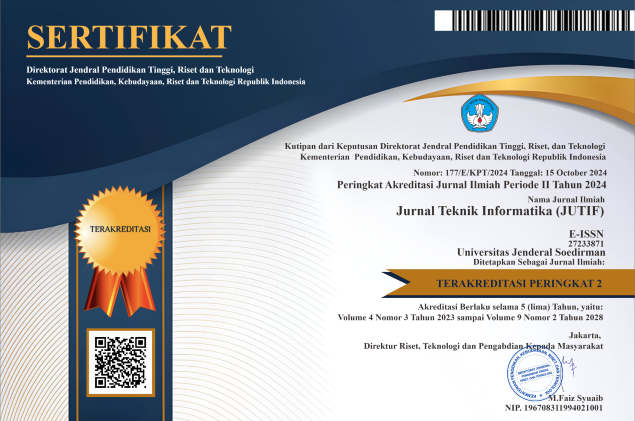Multi-architectural Transfer Learning CNN for Klowong Batik Fabric Defect Classification
DOI:
https://doi.org/10.52436/1.jutif.2025.6.4.4806Keywords:
Batik, Classification, CNN, KlowongAbstract
Klowong is a base cloth that has been given a hot wax pattern as the initial stage in the batik making process but has not yet become a finished batik. Nowdays, written batik machine are available but still limited and production defects still occur, reducing the value of batik. Manual QC makes subjective assessments, so an accurate and efficient automated inspection system is needed for SMEs.This study proposes a defect classification approach on batik klowong fabric based on transfer learning using deep convolutional neural networks (CNN) architecture that has been verified to be reliable in image classification schemes. The basic models used include VGG16, ResNet50V2, InceptionV3, and MobileNetV2, with modifications to the fully connected layers to reduce parameter complexity. The dataset consists of 1000 klowong fabric images with a resolution of 224×224 pixels, with a ratio of 80:10:10 for training, validation, and testing. Data augmentation was applied to improve the generalization of the model. Evaluation is performed based on accuracy, precision, recall, F1-score, and inference time. The experimental results show that VGG16 has the best performance in the testing stage with 92% accuracy. The combination of VGG16 with conventional classifiers (SVM and Random Forest) significantly speeds up the inference time (up to 0.0001 seconds per image) but with a decrease in accuracy to 81-83%. Therefore, the VGG16 model with the modified final layer is recommended as the optimal solution with the best trade-off between classification performance and computational efficiency, especially for application scenarios on low-resource devices such as batik SMEs.
Downloads
References
E. Sugiarto, F. Budiman, N. Hendriyanto, and A. Fahmi, “Optimization of Discrete Wavelet Transform Based on Gray Level Co-occurrence Matrix (GLCM) and Principal Component Analysis (PCA) to Improve Features Extraction on Batik Pattern Recognition,” IJETAE, 2023, doi: 10.46338/ijetae0523_12.
D. S. E. Atmaja, S. Wibirama, M. K. Herliansyah, and A. Sudiarso, “Comparative study of integral image and normalized cross-correlation methods for defect detection on Batik klowong fabric,” Results in Engineering, vol. 25, p. 104124, Mar. 2025, doi: 10.1016/j.rineng.2025.104124.
F. Abdullah, S. Bt. Basar, D. M. Sya’bany, and A. Mohd. Adnan, “Transformation from manual to digital: Artificial Intelligence in batik education for 5.0 society,” SHS Web Conf., vol. 197, p. 03001, 2024, doi: 10.1051/shsconf/202419703001.
S. B. Silah, B. Isa, Ponimin, and T. Karyono, “Malaysian and Indonesian Batik: The Best Practices,” KnE Social Sciences, pp. 47–55, 2021, doi: 10.18502/kss.v5i6.9177.
M. N. D. Ulhaq and A. Sudiarso, “Parameter Optimization of Writing Batik Machine with Synthetic & Natural Fabric,” J. Ind. Eng. Edu., vol. 1, no. 2, pp. 1–35, 2023, [Online]. Available: https://jiee.bksti.org/index.php/iee/article/view/20
M. W. Ilahi, C. N. Apriyani, A. Desiani, N. Gofar, Y. Andriani, and M. R. Halim, “Classification of Geometric Batik Motif Typical of Indonesian Using Convolutional Neural Network,” j. Teknik inform., vol. 15, no. 1, pp. 91–100, 2022, doi: 10.15408/jti.v15i1.24968.
W. Chen, B. Yang, J. Li, and J. Wang, “An Approach to Detecting Diabetic Retinopathy Based on Integrated Shallow Convolutional Neural Networks,” IEEE Access, vol. 8, pp. 178552–178562, 2020, doi: 10.1109/ACCESS.2020.3027794.
H. Song, X.-Y. Han, C. E. Montenegro-Marin, and S. Krishnamoorthy, “Retraction Note: Secure prediction and assessment of sports injuries using deep learning based convolutional neural network,” J Ambient Intell Human Comput, vol. 15, no. 8, pp. 3273–3273, 2024, doi: 10.1007/s12652-024-04823-w.
F. A. A., A. Soleymani, and H. Khosravi, “A Method for Automatic Lane Detection using a Deep Network,” IJE, vol. 35, no. 04, pp. 802–809, 2022, doi: 10.5829/IJE.2022.35.04A.20.
Z. Bai and J. Jing, “Mobile-Deeplab: a lightweight pixel segmentation-based method for fabric defect detection,” J Intell Manuf, vol. 35, no. 7, pp. 3315–3330, Oct. 2024, doi: 10.1007/s10845-023-02205-1.
I. A. Dewi and M. A. N. E. Salawangi, “High performance of optimizers in deep learning for cloth patterns detection,” IJ-AI, vol. 12, no. 3, p. 1407, Sep. 2023, doi: 10.11591/ijai.v12.i3.pp1407-1418.
M. Khodadadi, L. Riazi, and S. Yazdani, “A Novel Ensemble Deep Learning Model for Building Energy Consumption Forecast,” IJE, vol. 37, no. 6, pp. 1067–1075, 2024, doi: 10.5829/IJE.2024.37.06C.03.
E. Charoqdouz and H. Hassanpour, “Feature Extraction from Several Angular Faces Using a Deep Learning Based Fusion Technique for Face Recognition,” IJE, vol. 36, no. 8, pp. 1548–1555, 2023, doi: 10.5829/IJE.2023.36.08B.14.
K. Azmi, S. Defit, and S. Sumijan, “Implementasi Convolutional Neural Network (CNN) Untuk Klasifikasi Batik Tanah Liat Sumatera Barat,” JURNAL TEKNOLOGI UNIVERSAL, vol. 16, no. 1, pp. 28–40, 2023, doi: 10.52072/unitek.v16i1.504.
H. Fonda, “Klasifikasi Batik Riau Menggunakan Convolutional Neural Networks (CNN),” jik, vol. 9, no. 1, pp. 7–10, 2020, doi: 10.33060/JIK/2020/Vol9.Iss1.144.
J. Fan, W. K. Wong, J. Wen, C. Gao, D. Mo, and Z. Lai, “Fabric Defect Detection Using Deep Convolution Neural Network,” AATCC Journal of Research, vol. 8, no. 1_suppl, pp. 143–150, 2021, doi: 10.14504/ajr.8.S1.18.
M. A. Rasyidi, R. Handayani, and F. Aziz, “Identification of batik making method from images using convolutional neural network with limited amount of data,” Bulletin EEI, vol. 10, no. 3, pp. 1300–1307, Jun. 2021, doi: 10.11591/eei.v10i3.3035.
R. Mawan, “Klasifikasi motif batik menggunakan Convolutional Neural Network,” JNNLK, pp. 45–50, 2020, doi: 10.36802/jnanaloka.2020.v1-no1-45-50.
E. Sugiarto, F. Budiman, and A. Fahmi, “Implementation of Deep Learning Based on Convolution Neural Network for Batik Pattern Recognition,” KINETIK, 2025, doi: 10.22219/kinetik.v10i1.2019.
D. W. Pratama, M. Ismail, R. Nurraudah, A. P. Rifai, and H. T. Nguyen, “Classification of Metal Surface Defects Using Convolutional Neural Networks (CNN),” Green Intell. Syst. Appl., vol. 5, no. 1, pp. 93–105, 2025, doi: 10.53623/gisa.v5i1.581.
S. R. Arshad and M. K. Shahzad, “Deep Learning Based Fabric Defect Detection,” Res. Rep. Comput. Sci., vol. 3, no. 1, Mar. 2024, doi: 10.37256/rrcs.3120244156.
A. S. Paymode and V. B. Malode, “Transfer Learning for Multi-Crop Leaf Disease Image Classification using Convolutional Neural Network VGG,” Artificial Intelligence in Agriculture, vol. 6, pp. 23–33, 2022, doi: 10.1016/j.aiia.2021.12.002.
U. Sanath Rao et al., “Deep Learning Precision Farming: Grapes and Mango Leaf Disease Detection by Transfer Learning,” Global Transitions Proceedings, vol. 2, no. 2, pp. 535–544, 2021, doi: 10.1016/j.gltp.2021.08.002.
M. Mohsin, O. S. Balogun, K. Haataja, and P. Toivanen, “Real-time defect detection and classification on wood surfaces using deep learning,” ei, vol. 34, no. 10, pp. 382-1-382–6, Jan. 2022, doi: 10.2352/EI.2022.34.10.IPAS-382.
M. D. Bloice, P. M. Roth, and A. Holzinger, “Biomedical image augmentation using Augmentor,” Bioinformatics, vol. 35, no. 21, pp. 4522–4524, 2019, doi: 10.1093/bioinformatics/btz259.
P. A. Pramesti et al., “Classification of Clove Leaf Blister Blight Disease Severity Using Pre-trained Model VGG16, InceptionV3, and ResNet,” Jurnal Ilmu Komputer dan Informasi, vol. 17, no. 2, pp. 159–166, 2024, doi: 10.21609/jiki.v17i2.1237.
Z. Jiang, “A Novel Crop Weed Recognition Method Based on Transfer Learning from VGG16 Implemented by Keras,” IOP Conf. Ser.: Mater. Sci. Eng., vol. 677, no. 3, p. 032073, 2019, doi: 10.1088/1757-899X/677/3/032073.
I. Ramadhanti, A. Prasetiadi, and I. Kresna A, “CLOTHING RECOMMENDATION AND FACE SWAP MODEL BASED ON VGG16, AUTOENCODER, AND FACIAL LANDMARK POINTS,” J. Tek. Inform. (JUTIF), vol. 5, no. 1, pp. 19–29, 2024, doi: 10.52436/1.jutif.2024.5.1.1016.
Y. Pamungkas, M. R. N. Ramadani, and E. N. Njoto, “Effectiveness of CNN Architectures and SMOTE to Overcome Imbalanced X-Ray Data in Childhood Pneumonia Detection,” Journal of Robotics and Control, vol. 5, no. 3, pp. 775–785, 2024, doi: 10.18196/jrc.v5i3.21494.
D. R. A. N. Pratama and Y. Azhar, “Convolutional Neural Network for COVID-19 Detection Using InceptionV3 Transfer Learning,” J. Tek. Inform. (JUTIF), vol. 6, no. 2, pp. 483–500, 2025, doi: 10.52436/1.jutif.2025.6.2.4094.
A. G. Howard et al., “MobileNets: Efficient Convolutional Neural Networks for Mobile Vision Applications,” 2017, arXiv: arXiv:1704.04861. doi: 10.48550/arXiv.1704.04861.
K. R. Prilianti, V. V. Oktariyanto, and H. Setiawan, “Ornamental Plant Identification System Using Transfer Learning On Convolutional Neural Network,” J. Tek. Inform. (JUTIF), vol. 5, no. 4, pp. 1015–1023, 2024, doi: 10.52436/1.jutif.2024.5.4.1964.
T. T. Mengistie and D. Kumar, “Covid-19 Face Mask Detection Using Convolutional Neural Network and Image Processing,” in 2021 2nd International Conference for Emerging Technology (INCET), Belagavi, India: IEEE, May 2021, pp. 1–7. doi: 10.1109/INCET51464.2021.9456288.
W. Wahyuningsih, G. S. Nugraha, and R. Dwiyansaputra, “Classification Of Dental Caries Disease In Tooth Images Using A Comparison Of Efficientnet-B0, Mobilenetv2, Resnet-50, Inceptionv3 Architectures,” J. Tek. Inform. (JUTIF), vol. 5, no. 4, pp. 177–185, 2024, doi: 10.52436/1.jutif.2024.5.4.2187.
A. H. I. Al-Rammahi, “Face mask recognition system using MobileNetV2 with optimization function,” Applied Artificial Intelligence, vol. 36, no. 1, p. 2145638, 2022, doi: 10.1080/08839514.2022.2145638.
P. Yuan and C. Zhu, “Frequency Ensemble Based on Multi-Band Checkpoint Saving Mechanism for Time Series Forecasting,” in 2024 9th International Conference on Intelligent Computing and Signal Processing (ICSP), Xian, China: IEEE, 2024, pp. 714–717. doi: 10.1109/ICSP62122.2024.10743879.
Additional Files
Published
How to Cite
Issue
Section
License
Copyright (c) 2025 Dhika Wahyu Pratama, Andi Sudiarso, Denny Sukma Eka Atmaja, Muhammad Kusumawan Herliansyah

This work is licensed under a Creative Commons Attribution 4.0 International License.



























